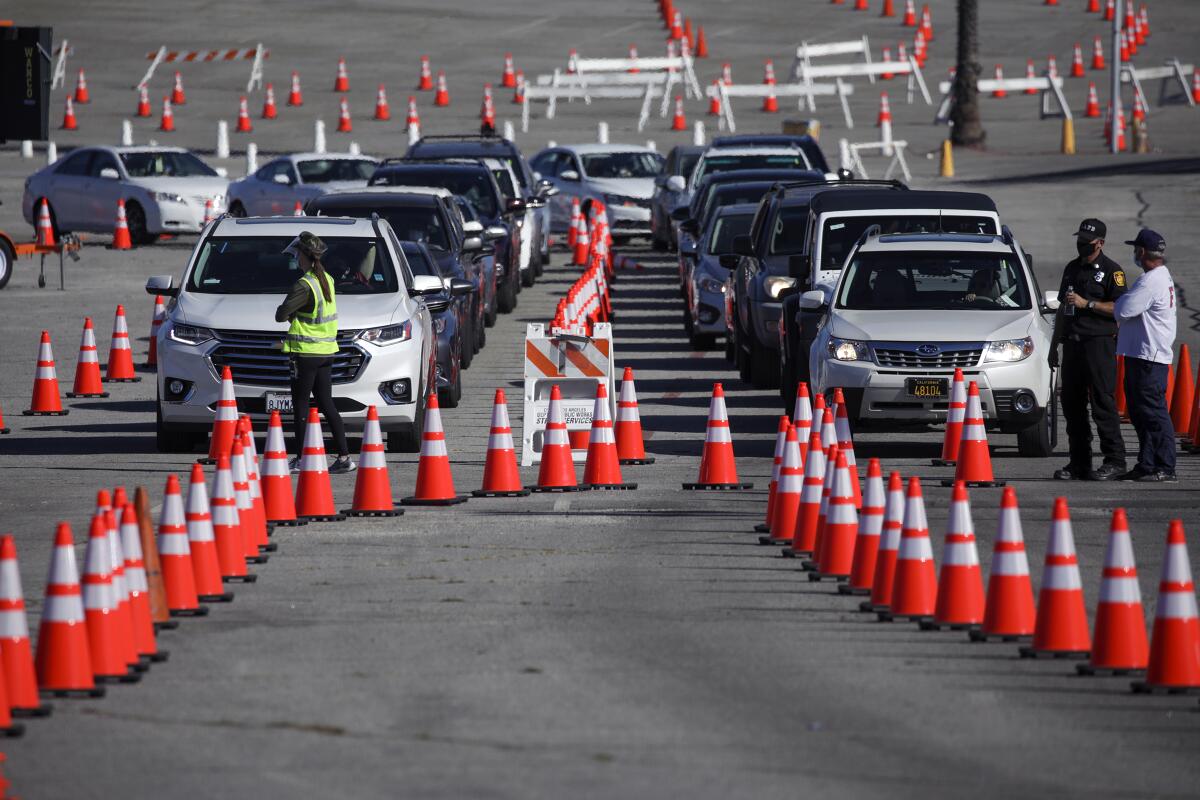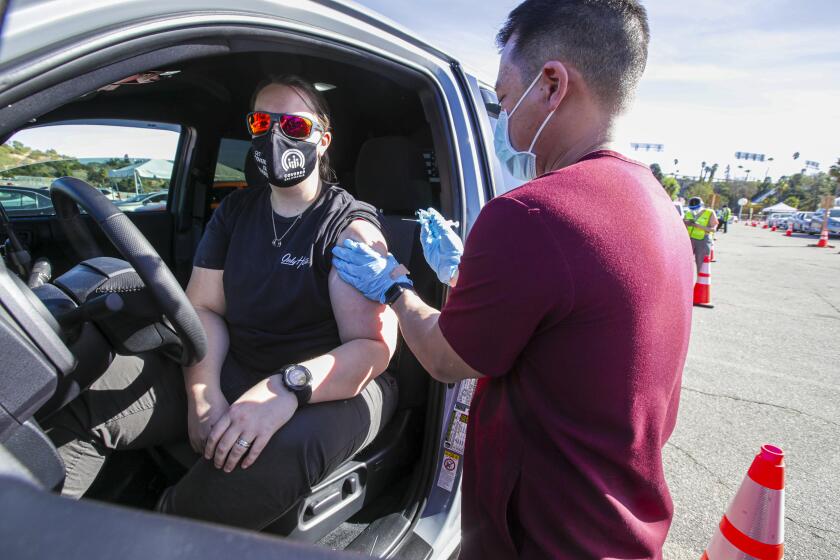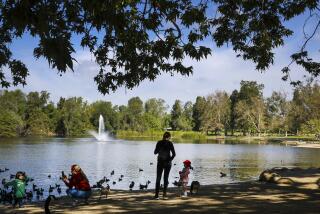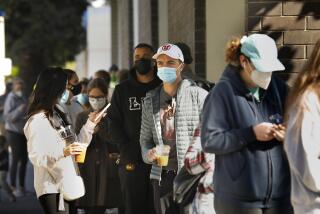âNeed a lot of both.â Will Californiaâs vaccine ramp-up squeeze out COVID-19 testing?

California Gov. Gavin Newsom, under growing pressure to jump-start a faltering COVID-19 vaccine rollout, jetted to Los Angeles on Jan. 15 to unveil a massive new vaccination site at Dodger Stadium that is expected eventually to inoculate 12,000 people a day.
The city-run venue had been the biggest COVID testing site in the U.S., administering more than 1 million tests in its nearly eight months of operation â and over 10,000 a day during the recent surge. Its redeployment to the cause of vaccination, Newsom declared, provides âan extraordinary world-class site for a world-class logistics operation.â
That effort came with a trade-off: When the city of Los Angeles ended COVID tests at Dodger Stadium and closed another testing site to help staff the new vaccination center, it removed, at least temporarily, about one-third of all government-run testing in Los Angeles County â the nationâs largest county, with a population of 10 million, and one of the biggest COVID hot spots.
Sites operated by the city, county or state account for just over one-third of all COVID tests in L.A. County, said Dr. Clemens Hong, who heads the countyâs testing operations.
Diminished testing capacity could lead to longer waits for appointments, which means infected people could potentially expose others for a longer time before learning they have the virus.
Dodger Stadium and other mass vaccination sites will be key in Californiaâs effort to accelerate its COVID-19 vaccination rate.
But L.A. Mayor Eric Garcetti said that has not happened so far. In what he called an instance of âperfect timing,â infection rates in L.A. County have declined since Dodger Stadium switched to vaccinations, and demand for tests has dropped by half to two-thirds, the mayor said Thursday. âWe are meeting the need â actually exceeding the need.â
Still, he acknowledged that converting the stadium had been a risk â one the city took because âthe vaccines will prevent and heal and finally resolve this.â
Many health experts agree that prioritizing vaccination over testing is the right move.
âThe best way out of our current crisis is masks, few contacts per day and vaccines, so it makes sense to create lots more access points for vaccinations even if it means a bit less testing,â said Dr. Bob Kocher, a senior fellow at USCâs Schaeffer Center for Health Policy & Economics and a former member of the stateâs COVID-19 Testing Task Force.
But with COVID caseloads still high despite their recent decline from peak levels, and mutant strains of the virus threatening to fuel new outbreaks, some senior public health officials say testing remains an equally vital part of the effort to contain â and ultimately suppress â the pandemic.
And it could become even more important in the coming months, as the inoculation campaign gains steam, since the tests could prove a valuable tool for assessing how well the vaccines are working.
âItâs hard to say right now, given how many people are sick with COVID, that vaccine is more important,â Hong said. âItâs hard to balance those two against each other, because we really just need a lot of both.â
Balancing vaccinations with testing and other COVID-related tasks is a significant challenge for public health officials across California and the nation, because those functions draw on many of the same resources â especially the staff needed for administration and record-keeping.
At vaccination sites, keeping good records is essential for planning from day to day how many doses to pull out of the freezer.
âItâs got to be done right, or else you screw up when the second dose is,â said Dr. George Rutherford, an epidemiologist at UC San Francisco.
Sara Bosse, public health director of Madera County, noted that counties across the state have asked Newsom for $400 million in the current budget year to help defray the costs of setting up vaccination sites, including facility costs, security, data entry staffers and clinicians to give the shots and watch for adverse side effects. They are also seeking $280 million for COVID testing and $440 million for contact tracing and non-group housing to protect COVID-vulnerable residents.
âI think that many counties are prioritizing vaccination, and based on the resources they have, they may pull from various parts of the COVID response such as contact tracing or testing,â Bosse said. The funding, she said, would help county health officials avoid âthose difficult decisions where we have to pull from one part of the COVID response to prop up the next.â
There could also be federal help on the way: President Biden has announced plans to establish 100 federally supported vaccination centers and allocate $50 billion to expand testing.
In Madera County, a poor rural area of 160,000 people that stretches from the Central Valley into the Sierra Nevada, the state has largely taken over COVID testing, allowing the county to focus its resources on vaccinations, Bosse said.
The big challenge on that front, she said, is having enough trained health personnel to run the vaccination sites. The county recently heard from 85 trained clinicians willing to volunteer for the vaccine effort, âwhich is going to be a game-changer for us,â Bosse said.
In Los Angeles, the city has the means to add testing capacity elsewhere and beef up mobile testing, Garcetti said. It had been considering a testing site at Pierce College in the San Fernando Valley, âwhich it looks like we wonât need to open,â the mayor said.
The city, county and state are also discussing the possibility of a partnership to expand testing at Exposition Park in South L.A.
In San Diego County, health officials expect to face a challenge due to the competition for staffing between vaccination and testing, and they are hiring to meet the need, said Sarah Sweeney, a spokeswoman for the countyâs Health and Human Services Agency. The county hasnât yet converted testing venues to vaccination sites but expects to do so after vaccine supplies increase, she said.
San Bernardino County health officials are committed to maintaining testing at current volumes even as they ramp up vaccinations, said Corwin Porter, the director of public health. But he conceded that doing both at the same time âis a struggleâ because âwe donât have enough vaccine and we donât have enough staff.â
The county is holding hiring events every week and working with multiple partners to find additional resources, âbecause we are trying not to pull anything out of testing or contact tracing,â Porter said.
Beyond the resource question, another big challenge confronts health officials: âThere is an issue of divided attention,â said L.A. Countyâs Hong. âNow we have two big things to deal with â three if you include contact tracing. I think we will have to be thoughtful about our strategy.â
Itâs been a rocky rollout, but I felt like Iâd hit the lottery when I got my emailed confirmation, for a Pfizer injection at 12:15 on Thursday.
Once a broad swath of the population has been vaccinated, which could take many months, testing volume will probably drop off sharply, said UCSFâs Rutherford.
âI donât see hundreds of thousands of tests a day anymore, once we get well up on vaccinations,â he said. âYouâll be testing thousands of people to find tens of cases.â
In the meantime, L.A. County will probably add questions to its testing appointment website asking people about their vaccination status, Hong said. âThat way we can track whatâs happening in people who are vaccinated.â
Ongoing COVID outbreaks may require increased testing, particularly in poorer communities of color, which have been hit hardest by the pandemic â and where hesitancy to be vaccinated is probably more widespread, Hong said. âSo the bottom line is that testing is not going away.â
This story was produced by KHN (Kaiser Health News), which publishes California Healthline, an editorially independent service of the California Health Care Foundation. KHN is not affiliated with Kaiser Permanente.
More to Read
Sign up for Essential California
The most important California stories and recommendations in your inbox every morning.
You may occasionally receive promotional content from the Los Angeles Times.












